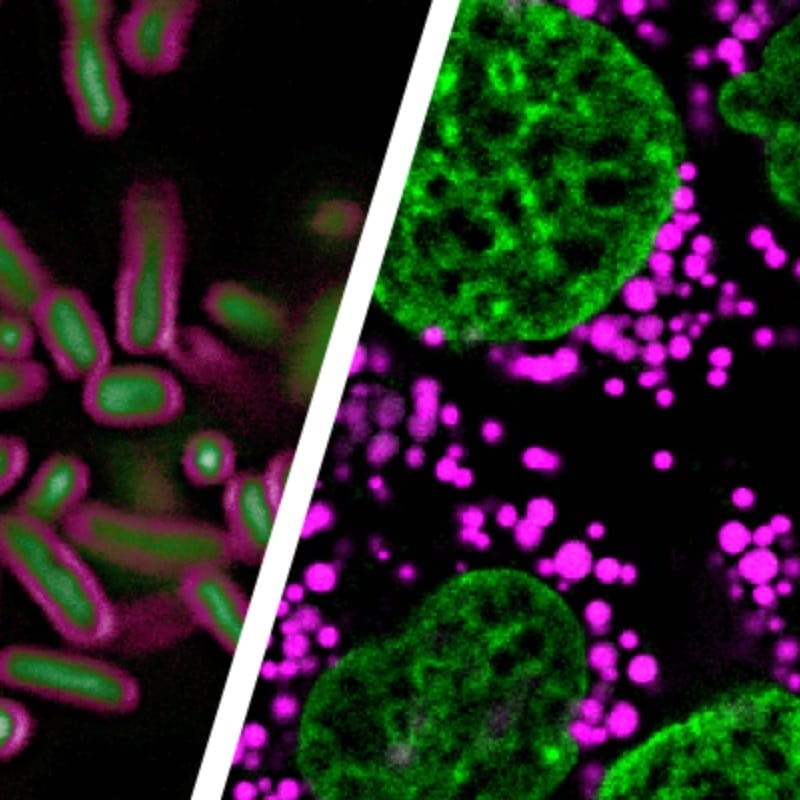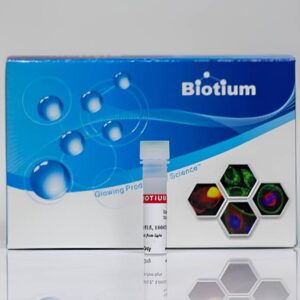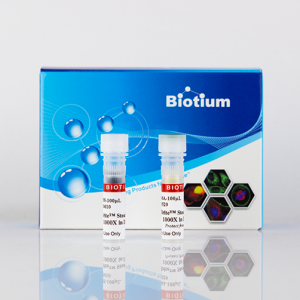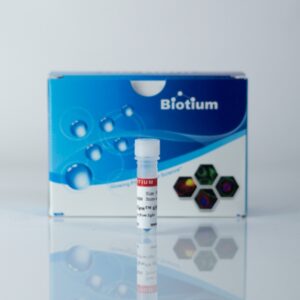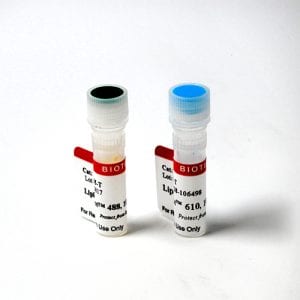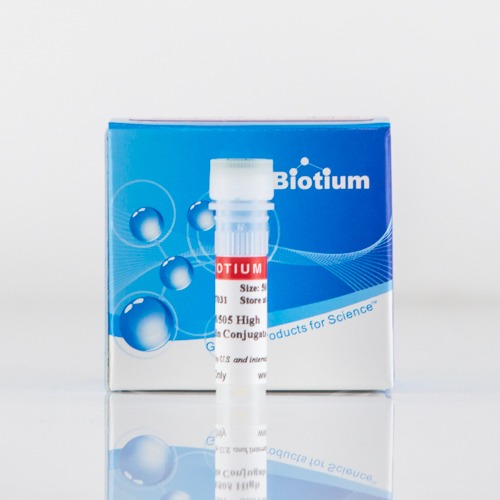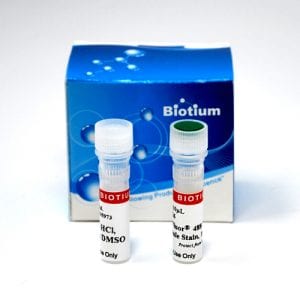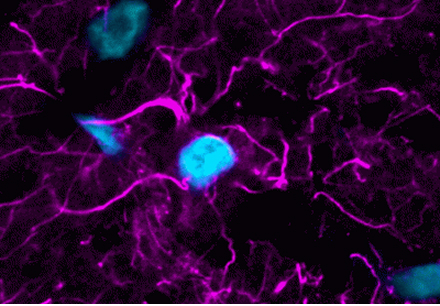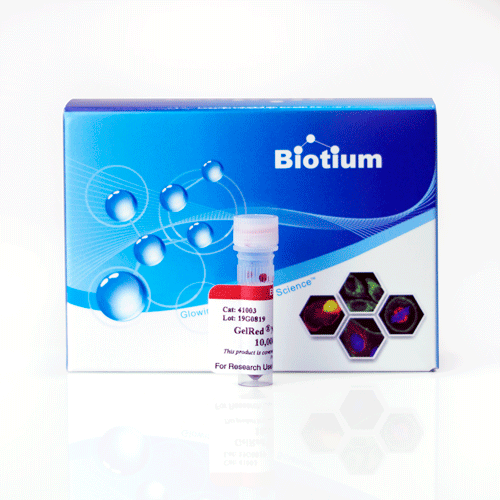| Product | Stains live cells | Fix after staining | Permeabilize after staining | Fix before staining | Non- cytotoxic | Color (Ex/Em)1 | Applications / Notes |
|---|---|---|---|---|---|---|---|
| DAPI Hoechst 33342 Hoechst 33258 | Yes | Yes | Yes | Yes | Yes | Blue (352/461 nm) | • Classic blue nuclear stains • No-wash, nontoxic, stable for several days • Use DAPI in antifade mounting medium |
| NucSpot® Live 488 | Yes | Yes | Yes | Yes | Yes | Green (500/515 nm) | • Green nuclear stain for live or fixed cells • No-wash, nontoxic for real-time imaging |
| Thiazole Green (SYBR® Green I) | Yes | No2 | No2 | No2 | No | Green (498/522 nm) | • Structurally identical to SYBR® Green I |
| Oxazole Gold (SYBR® Gold) | Yes | No2 | No2 | No2 | No | Green (496/539 nm) | • Structurally identical to SYBR® Gold • Live cell staining of nuclei and mitochondrial DNA |
| NucSpot® 470 | Dead cell- selective | No | No | Yes | Yes | Green (460/546 nm) | • No-wash green nuclear stain • Dead-cell selective in unfixed cells |
| NucSpot® 555/570 | Dead cell- selective | No | No | Yes | Yes | Red (559/566 nm) | • Nuclear-specific red counterstain for fixed cells • Specifically stains dead cells in live cultures |
| NucSpot® 568/580 | Dead cell- selective | No | No | Yes | Yes | Dark red (572/583 nm) | • Nuclear-specific red counterstain for fixed cells • Specifically stains dead cells in live cultures • Suitable for multi-day live cell imaging |
| NucSpot® 594/615 | Dead cell- selective | No | No | Yes | Yes | Deep red (603/613 nm) | • Nuclear-specific red counterstain for fixed cells • Specifically stains dead cells in live cultures • Suitable for multi-day live cell imaging |
| NucSpot® 650/665 | Dead cell- selective | No | No | Yes | Yes | Far-red (653/671 nm) | • Nuclear-specific far-red counterstain for fixed cells • Specifically stains dead cells in live cultures |
| NucSpot® Live 650 | Yes | Yes | Yes | Yes | Yes | Far-red (650/675 nm) | • Far-red nuclear stain for live or fixed cells • No-wash, nontoxic for real-time imaging |
| RedDot™1 Far-Red Nuclear Stain | Yes | No | No | No2 | No | Far-red (662/694 nm) | • No wash, far-red nuclear stain • Compare to Draq5™ • Endpoint only; toxic after several hours |
| RedDot™2 Far-Red Nuclear Stain | Dead cell- selective | No | No | Yes | Yes | Far-red (650/675 nm) | • No-wash, far-red nuclear stain • Dead cell-selective in unfixed cells • Compare to Draq7™ |
| NucSpot® 680/700 | Dead cell- selective | No | No | Yes | Yes | Near IR (683/707 nm) | • Nuclear-specific near-IR counterstain for fixed cells • Specifically stains dead cells in live cultures |
| NucSpot® 750/780 | Dead cell- selective | No | No | Yes | Yes | Near IR (750/780 nm) | • Nuclear-specific near-IR counterstain for fixed cells • Specifically stains dead cells in live cultures • Suitable for multi-day live cell imaging |
| Cell-Membrane Impermeant Nucleic Acid Dyes | Dead cell- selective | No | No | No2 | Yes | Multiple colors Blue to Far-Red | • PI, EthDIII, dimeric cyanine dyes, etc. • See Dead Cell & Apoptosis Stains • Nuclear staining in fixed cells requires RNase treatment |
2 Not nuclear-specific in fixed cells
SYBR is a registered trademark of Thermo Fisher Scientific
| Product | Localization | Fix after staining | Permeabilize after staining | Fix before staining | Non- cytotoxic | Staining stability1 | Colors | Applications / Notes |
|---|---|---|---|---|---|---|---|---|
| Hoechst 33342 Hoechst 33258 | Nucleus | Yes | Yes | Yes | Yes | Days | Blue (352/461 nm) | • No-wash, nontoxic, stable for several days |
| NucSpot® Live Nuclear Stains | Nucleus | Yes | Yes | Yes | Yes | Days | Green (500/515 nm) Far-red (650/675 nm) | • No-wash, nontoxic for real-time imaging |
| Thiazole Green | Nucleus & cytoplasm | Yes | Yes | Yes | No | < 4 hours | Green (498/522 nm) | • Structurally identical to SYBR® Green I • Very bright, no-wash staining of DNA • Shows some mitochondrial & cytoplasmic staining • Toxic after several hours |
| RedDot™1 Far-Red Nuclear Stain | Nucleus | No | No | No | No | < 4 hours | Far-red (662/694 nm) | • Compare to Draq5™ • Toxic after several hours |
| ViaFluor® Live Cell Microtubule Stains | Microtubules | No | No | No | Possibly toxic | Days | Blue (408/452 nm) Green (500/515 nm) Far-red (650/675 nm) | • No-wash, live cell microtubule stains • Low toxicity, stain for 48 hours or longer |
| ViaFluor® SE Cell Proliferation Dyes | Cell interior | Yes | Yes | No | Yes | Days | Blue (408/452 nm) Green (493/532 nm) Far-red (653/682 nm) | • Stable, whole-cell labeling of live cells • Non-toxic for tracking multiple cell divisions • Excellent choice for cell tracing or co-cultures |
| Calcein-AM | Cell interior / Cell viability | No | No | No | Yes | ≤ 24 h | Green (494/517 nm) | • Short-term, whole-cell labeling of live cells • For cell viability or dye efflux assays |
| Acridine Orange | Nucleus & Cytoplasm | Yes | Yes | Yes | Possibly toxic | Days | Green ( DNA) Red (RNA) | • Membrane permeant nucleic acid dye • Stains DNA green (Ex/Em 500/526 nm), RNA red (Ex/Em 496/650 nm) |
| CellBrite® Steady Membrane Staining Kits | Membrane/ Cell Surface | No | No | No | Yes | Days | 5 Colors Blue to Near-IR | • Image live cell surface for ≥24 hours • Optional Enhancer masks intracellular signal • Fast, even staining in complete medium • STORM-compatible options |
| CellBrite® Cytoplasmic Membrane Dyes | Membranes3 | Yes2 | No2 | Yes2 | Yes | Days to weeks3 | 8 Colors Blue to Near-IR | • Lipophilic carbocyanine membrane dyes • Fix before or after labeling2 • Stable & non-toxic for cell tracking3 |
| GlycoLiner™ Cell Surface Glycoprotein Labeling Kits | Membrane/ Cell Surface3 | Yes | Yes | No | Yes | Days3 | 5 Colors Blue to Near-IR | • Covalent membrane labeling • Less cytoplasmic background in dead cells • Stain yeast and Gram+ bacteria |
| CellBrite® Fix Membrane Stains | Membrane/ Cell Surface3 | Yes | Yes | No | Yes | Days3 | Green (480/513 nm) Red (542/571 nm) Far-Red (638/667 nm) | • Covalent membrane labeling • More uniform staining than lipophilic dyes • Stain yeast and bacteria |
| MemBrite® Fix Cell Surface Stains | Cell surface3 | Yes | Yes | No | Yes | Days3 | 12 Colors Blue to Near-IR | • Covalent labeling of surface proteins • Rapid, uniform cell surface staining • STORM-compatible dye options • Stain yeast and gram-positive bacteria |
| SynaptoGreen™ & SynaptoRed™ Nerve Terminal Dyes | Vesicles | Yes4 | Yes4 | No | Yes | Minutes to hours | Green (~480/600 nm) Red (~510/750 nm) | • Cationic styryl membrane dyes • Track vesicle trafficking & release • Dye options with fixable amine group • Equivalent to FM® dyes |
| CF® Dye Cholera Toxin Conjugates | Lipid rafts | Yes | Yes | Yes | Yes | ≤ 24 h | 6 colors Green to Near-IR | • Binds GM1 ganglioside in lipid rafts • For cell surface labeling or neuronal tracing • Staining can be heterogeneous in cultured cells |
| CF® Dye Transferrin Conjugates | Endocytic tracer | Yes | Yes | No | Yes | ≤ 24 h | 7 colors Green to Near-IR | • Transferrin receptor ligand • Traffics to recycling endosomes |
| CF® Dye Dextrans | Fluid phase tracer | Yes | No | No | Yes | ≤ 24 h | Wide selection Green to Near-IR | • Fluid phase endocytosis & permeability tracers • Range of molecular weights |
| WGA Conjugates ConA Conjugates PNA Conjugates | Glycoproteins | Yes | Yes | Yes | Possibly toxic | ≤ 24 h | Wide selection UV to Near-IR | • Bind to cell surface glycoproteins3 • Binding/biological effects vary by cell type • See Stains in Different Organisms for bacteria/yeast • Wide choice of CF® dye colors |
| LipidSpot™ Lipid Droplet Stains | Lipid droplets / Neutral lipids | Yes | Yes | Yes | Yes | ≥24 h | Green (427/585 nm) Far-red (610/663 nm) | • No wash, live or fixed cell staining • Tolerates permeabilization |
| LysoView™ Dyes | Lysosomes | No | No | No | Yes | Days | Blue, Green, Orange, Far-Red | • No wash, live cell staining of lysosomes |
| MitoView™ Dyes | Mitochondria/ Cell viability | No5 | No | No5 | Yes | Days | Blue, Green, Far-Red, Near-IR | • No wash, live cell staining of mitochondria • MitoView™ 633 is potential-dependent |
| MitoView™ Fix 640 | Mitochondria/ Cell viability | Yes | Yes | No | Yes | Days | Far-red (644/665 nm) | • No wash, non-toxic mitochondria staining • Stable for several days • Tolerates fixation and permeabilization |
| Aquaphile™ JC-1 JC-1, Iodide JC-1, Chloride JC-1 Mitochondrial Membrane Kit | Mitochondria/ Cell viability | No | No | No | Yes | Days | Green (510/527 nm, cytoplasm), Red (585/590 nm, healthy mitochondria) | • No wash, live cell staining of mitochondria • Measure mitochondrial potential/cell health • Green fluorescence in cytoplasm, red fluorescence in polarized mitochondria |
| TMRM TMRE | Mitochondria/ Cell viability | No | No | No | Yes | Days | Red (548/573 nm) | • No wash, live cell staining of mitochondria • Preferred dyes for quantitative mitochondrial membrane potential measurement |
| Annexin V Conjugates | Apoptotic cell membranes | Yes | No | No | Yes | Days | Wide selection UV to Near-IR | • Stain cell surface of apoptotic cells • Washing is optional • Azide-free options for real-time imaging |
| NucView® Caspase-3 Substrates | Apoptotic cell nuclei | Yes | Yes | No | Yes | Days | Blue (429/469 nm) Green (500/530 nm) Orange (528/563 nm) | • Detect caspase-3 activity in intact cells • No-wash assay for endpoint or real-time analysis • NucView® 488 tested in >100 cell types & 200 papers |
| Cell-Membrane- Impermeant Nucleic Acid Dyes | Necrotic cells6 | No | No | No6 | Yes | Days | Wide selection Green to Far-Red | • No wash staining for real-time imaging • See Dead Cell & Apoptosis Stains |
2 Formaldehyde fixation only, dyes do not tolerate alcohol/solvent treatment; dyes have poor tolerance for detergent, but cells can be stained after fixation/permeabilization with good results.
3 Surface staining is internalized by endocytosis, becoming mostly intracellular after several hours.
4 Dye options with formaldehyde-fixable amine groups; can be used with a low-detergent permeabilization protocol.
5 Cells can be fixed before or after MitoView™ Green staining, but dye localization will not be as specific as in live cells. We recommend mitochondrial marker antibodies for fixed cell staining.
6 Necrotic cell stains also stain late apoptotic cells with leaky membranes; staining is not dead cell-selective in fixed samples.
| Product | Target | Also stains live cells? | Color (Ex/Em) | Applications / Notes |
|---|---|---|---|---|
| Phalloidin Conjugates | F-actin | No | Wide selection UV to Near-IR | • Widely used stain for actin filaments • Formaldehyde-fixation only (no methanol fixation) |
| CF® Dye α-Bungarotoxin Conjugates | Nicotinic acetylcholine receptor | Yes | Wide selection UV to Near-IR | • Labels neuromuscular junctions |
| CytoLiner™ Fixed Cell Membrane Stains | Cell Membrane | Yes1 | 5 colors Blue to Near-IR | • Novel lipophilic dyes for bright & uniform membrane staining in fixed cells |
| CellBrite® Cytoplasmic Membrane Dyes | Cell Membrane | Yes | 8 colors Blue to Near-IR | • Lipophilic dyes for stable, non-toxic membrane labeling • Fix before or after labeling2 |
| CF® Dye WGA Conjugates CF® Dye ConA Conjugates CF® Dye PNA Conjugates | Glycoproteins | Yes | Wide selection UV to Near-IR | • Bind to cell surface glycoproteins • May stain intracellular targets in permeabilized cells • Staining is tissue- and cell-type dependent |
| CF® Dye Cholera Toxin Conjugates | GM1 ganglioside in lipid rafts | Yes | 6 colors Green to Near-IR | • For cell surface labeling or neuronal tracing • Expression/staining can be heterogeneous in cultured cells |
| LipidSpot™ Lipid Droplet Stains | Lipid droplets / Neutral lipids | Yes | Green (427/585 nm) and Far-red (610/663 nm in vegetable oil, ~592/638 nm in cells) | • Stain before or after fixation • Tolerates permeabilization after fixation |
| Organelle marker antibodies | Mitochondria, nuclear envelope, nucleoli, Golgi and more | No | Wide selection Blue to Near-IR | • Best options for fixed cell organelle staining |
| MitoView™ Green | Mitochondria | Yes | Green | • Can be used if suitable mitochondria antibody not available • Staining not as specific as in live cells |
2 Formaldehyde fixation only, dyes do not tolerate alcohol/solvent treatment; dyes have poor tolerance for detergent, but cells can be stained after fixation/permeabilization with good results.
| Product | Target | Nuclear- specific | Fix after staining | Permeabilize after staining | Color (Ex/Em) | Applications / Notes |
|---|---|---|---|---|---|---|
| Oxazole Blue | Necrotic cells1 Cell-impermeant DNA/RNA dye | No | No | No | Blue (434/457 nm)2 | • Cell-impermeant monomeric nucleic acid dye • Reported to selectively stain early apoptotic cells • Equivalent to PO-PRO™-1 |
| Oxazole Blue Homodimer | Necrotic cells1 Cell-impermeant DNA/RNA dye | No | No | No | Blue (433/457 nm)2 | • Cell-impermeant monomeric nucleic acid dye • Equivalent to POPO™-1 |
| NucView® Caspase-3 Substrates | Apoptotic cells Caspase activity | Yes | Yes | Yes | Blue (429/469 nm)2 Green (500/530 nm)2 Orange (528/563 nm)2 | • Detect caspase-3 activity in intact cells • No-wash assay for endpoint assay or real-time analysis • NucView® 488 validated in >100 cell types & 200 papers |
| CF® Dye Annexin Conjugates | Apoptotic cells Phosphatidylserine | No | Yes | No | Wide selection UV to Near-IR | • Annexin V with CF® dyes & other labels • Available preservative-free for real-time cell imaging |
| Live-or-Dye™ Fixable Viability Stains | Necrotic cells1 Cell-impermeant reactive dyes | No | Yes | Yes | 8 Colors UV to Near-IR | • Covalent labeling of dead cell cytoplasm • Excellent tolerance for fixation/permeabilization • Wash required after staining |
| NucSpot® Nuclear Stains | Necrotic cells1 Cell-impermeant DNA dyes | Yes | No | No | 7 Colors Green to Near-IR | • Nuclear-specific counterstains or dead cell stains • No-wash staining, compatible with real-time imaging |
| Oxazole Yellow | Early apoptotic cells Cell-impermeant DNA/RNA dye | No | No | No | Green (491/506 nm)2 | • Equivalent to YO-PRO®-1 Iodide • Reported to selectively stain early apoptotic cells • No-wash staining, compatible with real-time imaging |
| Oxazole Yellow Homodimer | Early apoptotic cells Cell-impermeant DNA/RNA dye | No | No | No | Green (491/508 nm)2 | • Equivalent to YOYO®-1 Iodide • No-wash staining, compatible with real-time imaging |
| TO Iodide | Necrotic cells1 Cell-impermeant DNA/RNA dye | No | No | No | Green (515/531 nm)2 | • Equivalent to TO-PRO®-1 Iodide • No-wash staining, compatible with real-time imaging |
| Thiazole Orange Homodimer | Necrotic cells1 Cell-impermeant DNA/RNA dye | No | No | No | Green (514/531 nm)2 | • High-affinity dimeric cyanine DNA/RNA dye • Equivalent to TOTO®-1 Iodide • No-wash staining, compatible with real-time imaging |
| PathoGreen™ Histofluorescent Stain | Degenerating neurons | No | N/A | N/A | Green (497/520 nm) | • For fixed neuronal cells/tissue sections |
| CF® Dye TUNEL Assay | Apoptotic cells DNA strand breaks | Yes | N/A | N/A | Green (490/515 nm) Red (593/614 nm) Far-red (642/662 nm) | • Label dsDNA breaks with bright, photostable CF® dyes • For fixed cells or tissue sections |
| Live-or-Dye NucFix™ Red | Necrotic cells1 Cell-impermeant DNA/RNA dye | Yes3 | Yes | Yes | Red (520/610 nm)2 | • Covalent, red fluorescent dead cell nuclear stain • The only fixable dead cell nuclear stain • Wash after staining required |
| Ethidium Homodimer III | Necrotic cells1 Cell-impermeant DNA/RNA dye | No | No | No | Red (530/620 nm)2 | • Developed at Biotium as an alternative to EthDI • 45% brighter than EthDI when bound to DNA |
| Ethidium Homodimer I | Necrotic cells1 Cell-impermeant DNA/RNA dye | No | No | No | Red (528/616 nm)2 | • High-affinity membrane-impermeant DNA/RNA stain • >30-fold fluorescence enhancement upon binding DNA |
| Propidium Iodide | Necrotic cells1 Cell-impermeant DNA/RNA dye | No | No | No | Red (535/617 nm)2 | • Can be excited at 488 nm for the PE channel • Useful for cell cycle analysis in fixed cells (with RNase) |
| RedDot™2 Far-Red Nuclear Stain | Necrotic cells1 Cell-impermeant DNA/RNA dye | Yes | No | No | Far-red (662/694 nm)2 | • Far-red nuclear counterstain or dead cell stain • Compare to Draq7™ • No-wash staining, compatible with real-time imaging |
| Thiazole Red Homodimer | Necrotic cells1 Cell-impermeant DNA/RNA dye | No | No | No | Far-red (642/661 nm)2 | • High-affinity dimeric cyanine DNA/RNA dye • Equivalent to TOTO®-3 Iodide • No-wash staining, compatible with real-time imaging |
| Thiazole Red | Necrotic cells1 Cell-impermeant DNA/RNA dye | No | No | No | Far-red (642/657 nm)2 | • Equivalent to TO-PRO®-1 Iodide • No-wash staining, compatible with real-time imaging |
| 7-AAD | Necrotic cells1 Cell-impermeant DNA/RNA dye | No | No | No | Far-Red (546/647 nm)2 | • Far-red dye for the PE-Cy®5 flow cytometry channel • Can be excited by the 488 nm or 532 nm laser line • Useful for cell cycle analysis in fixed cells |
| NucSpot® Far-Red | Necrotic cells1 Cell-impermeant DNA/RNA dye | No | No | No | Far-Red (597/667 nm)2 | • Designed as improved replacement for 7-AAD • For flow cytometry in the PE-Cy®5 or APC channel • Less bleed into the PE-Texas Red® channel • Useful for cell cycle analysis in fixed cells |
2 With DNA.
2 Not nuclear-specific in yeast.
Cy Dye is a registered trademark of Cytiva; POPO, TOTO, YOYO, TO-PRO, PO-PRO, and YO-PRO are trademarks or registered trademarks of Thermo Fisher Scientific; Draq5 and Draq7 are trademarks of Biostatus, Ltd.
| Product | Live or Fixed Cells? | RNase treatment required? | Color (Ex/Em)1 | Applications / Notes |
|---|---|---|---|---|
| NucSpot® 470 | Fixed | No | Green (460/546 nm) | • Nuclear-specific green counterstain for fixed cells • Selectively stains dead cells in live cultures • Excellent match for blue LED excitation sources |
| Propidium Iodide | Fixed | Yes | Red (535/617 nm) | • Widely used dead cell stain • Can be excited by 488 nm laser line for detection in the PE channel |
| 7-AAD | Fixed | No | Far-Red (546/647 nm) | • Far-red dye for detection in the PE-Cy®5 channel • Can be excited by the 488 nm or 532 nm laser line |
| NucSpot® Far-Red | Fixed | No | Far-Red (597/667 nm) | • Designed as improved replacement for 7-AAD • For the PE-Cy®5 or APC channel • Less bleed into the PE-Texas Red® channel |
| RedDot™1 Far-Red Nuclear Stain | Live | No | Far-red (662/694 nm) | • For short-term live cell staining (≤4 hours) • Useful for cell number normalization for In Cell Western® • Can be excited at wavelengths between 488 and 647 nm • Detect in Cy®5 or APC channel |
Cy Dye is a registered trademark of Cytiva. In Cell Western is a registered trademarks of LI-COR Inc.
| Product | Target | Fixable? | Tolerates optical clearing? | Applications / Notes |
|---|---|---|---|---|
| Hoechst 33342 Hoechst 33258 | All cell nuclei | Yes | Yes | • See Nuclear Stains |
| NucSpot® Live Nuclear Stains | All cell nuclei | Yes | ND | • See Nuclear Stains |
| Live-or-Dye NucFix™ Red | Dead cell nuclei | Yes | Yes | • See Dead Cell & Apoptosis Stains |
| CellBrite® Cytoplasmic Membrane Dyes | Cell membranes | Yes1 | No | • Lipophilic carbocyanine dye have been used for labeling cells before or after spheroid formation • See Live Cell Stains |
| MitoView™ Dyes | Mitochondria | No | No | • See Live Cell Stains |
| NucView® 488 Caspase-3 Substrate | Apoptotic cells | Yes | Yes | • See Dead Cell & Apoptosis Stains |
| Calcein-AM | Viable cells (whole cell interior) | No | No | • Commonly used to stain cells in Matrigel® or spheroids • See Live Cell Stains |
| Cell-Membrane Impermeant Nucleic Acid Dyes | Necrotic cells2 | No | No | • See Dead Cell & Apoptosis Stains |
| ViaFluor® SE Cell Proliferation Dyes | Whole cell interior | Yes | Yes | • Can be used to label cells before seeding in Matrigel® or spheroids • See Live Cell Stains |
| LipidSpot™ Lipid Droplet Stains | Lipid droplets | Yes1 | ND | • LipidSpot™ 488 has been validated for staining 3D cell spheroids |
| ViaFluor® Live Cell Microtubule Stains CellBrite® Steady Membrane Staining Kits LysoView™ Dyes | Membrane and various organelles | No | ND | • May be suitable for staining spheroids, 3D cultures, or Matrigel® cultures, but have not yet been validated |
2 Necrotic cell stains also stain late apoptotic cells with leaky membranes; staining is not dead cell-selective in fixed samples.
Matrigel is a registered trademark of Corning, Inc.
Cellular Stains in Different Organisms
2 Internalizes to vacuolar membranes
3 Stains bud scars of budding yeast
4 Weak staining and not nuclear
5 Staining is not nuclear
6 Initially stains mitochondria, then redistributes to nucleus & cytoplasm
7 Dead cell specific but not nuclear
8 Stains live and dead cells
9 Not cytoplasmic, stains cell periphery
10 Staining is not lysosomal
11 Not predicted to bind yeast/bacteria cytoskeleton
12 Staining is both nuclear and cytoplasmic
FUN1 is a registered trademark of Thermo Fisher Scientific
